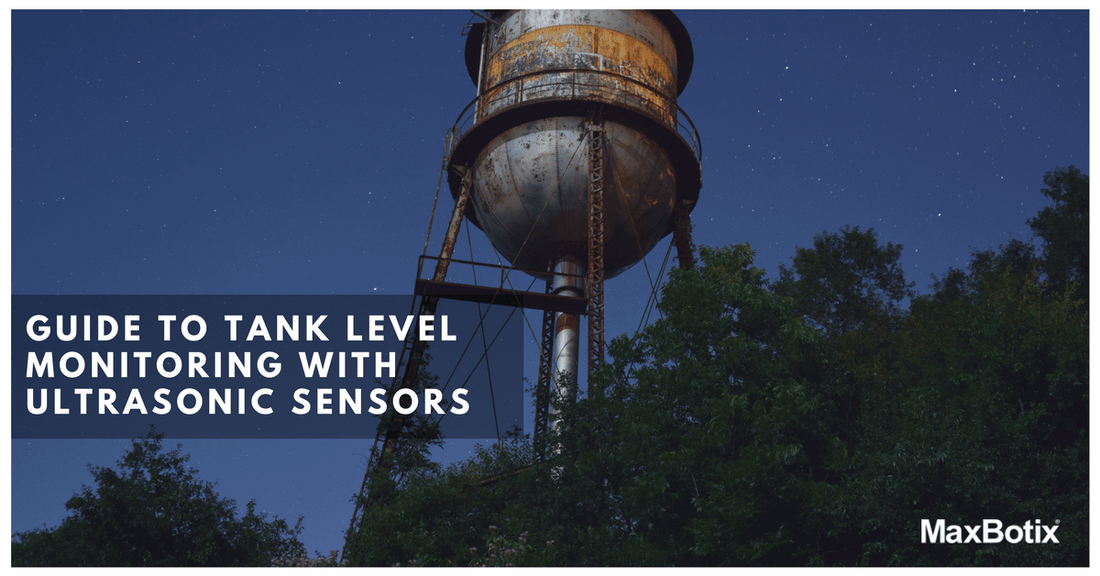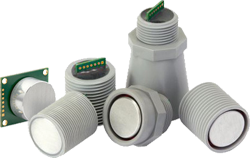These are important factors to consider when mounting your sensor in a tank.
- Avoidance of obstructions - The wall of the tank or other obstructions in the tank will give inaccurate readings.
- Placement can affect readings - Our filtering protocol allows the sensor to prioritize large targets over small targets and noise. This is beneficial in tank level monitoring applications as the liquid level tends to give the largest acoustic return.
- Beware of the fill stream - The fill stream can also be an obstruction that you may not consider initially in your application.
Tip - When mounting an ultrasonic sensor in a tank, the position of the sensor is very important to the application. The mounting position of the sensor affects the reliability and consistent performance.
Concerned about reflections off the side of your tank?
Our sensors offer a narrow beam pattern, reducing the chance the sensor will detect the wall of the tank, which can solve your problem depending on the diameter of your tank. If the tank has smooth walls on the inside, our MB7052 and MB7369 sensors contain our Most-likely and stability filtering. This will let the sensors choose the target that gives the largest acoustic return. This will generally be the liquid level inside of the tank.If the tank is corrugated or does not have smooth inside walls, this will likely have a negative impact the performance of the sensor. We recommend that you contact us at support@maxbotix.com to get the most appropriate sensor recommended for use.
Are you measuring chemicals (liquid/gas) in your tank or water with high levels of chemicals?
Many chemicals or gases can have an effect on electronics/metals that would cause corrosion or damage, and as such, we offer the F-option (fluorosilicone sealant) and P-option (parylene coating) for our sensors for operation near or with hazardous chemicals or gases/fumes.What are F-option (fluorosilicone sealant) (IP68) and P-option (parylene coating) for our sensors?
- The F-option adds additional water/particulate protection.
- The P-option is a parylene coating applied to the aluminum transducer surface for added protection against corrosion.
Review Our Chemical Compatibility Guide
Measuring Fossil Fuels
If you will be measuring in a tank that contains fossil fuels, it is recommended that you add the F-option and P-option for added corrosion resistance and protection of the sensitive electronic components. We do list the exposed elements on any of our weather resistant sensors. Do note that you are responsible to ensure that any harsh chemicals will not damage the exposed materials.Measuring Oil in a Sealed Tank
What to consider when mounting an ultrasonic sensor in a sealed oil tank:- Is there a chance that condensation or frost will form on the sensor?
- What are the minimum and maximum range requirements for your operation?
- What is the desired read/refresh rate for your application?
- Do you have a preferred sensor resolution? Our sensors report distance in the following resolutions: inches, centimeters, and millimeters.
- Do you have a preferred sensor output? (RS232, TTL, I2C, Pulse-Width, Analog Voltage, Analog Envelope)
- At what voltage level do you plan to operate the sensor?
Items to consider: Picking the best sensor for your tank level monitoring application.
- The dimensions of the tank you will be measuring in.
- Is the tank corrugated or does it have smooth walls?
- What is the minimum range needed for your application?
- What is the tank use? Oil & gas, water, bulk storage, chemical storage, other?
- How quickly will the liquid level of the tank change over time?
 LX Group - Ultrasonic Distance Sensor for Tank Level Measurement This sensor unit developed by LX Group has been used in grain silos, water tanks, and dams. A great solution when your goal is to monitor the level of water tanks remotely. This plug and play solution works right out of the box in rough environments.
LX Group - Ultrasonic Distance Sensor for Tank Level Measurement This sensor unit developed by LX Group has been used in grain silos, water tanks, and dams. A great solution when your goal is to monitor the level of water tanks remotely. This plug and play solution works right out of the box in rough environments.  Invigicom - Wireless Ultrasonic Tank Level Sensor This easy solution can replace a traditional tank monitoring system that uses float gauges or pressure sensors. Implement an easy to use solution for wireless ultrasonic tank level monitoring, get email alerts for tank servicing.
Invigicom - Wireless Ultrasonic Tank Level Sensor This easy solution can replace a traditional tank monitoring system that uses float gauges or pressure sensors. Implement an easy to use solution for wireless ultrasonic tank level monitoring, get email alerts for tank servicing.  In the back office, Invigicom monitors the system for problems. Many times they see the problems before the customer does and is able to fix them remotely. NCD - Long Range Wireless Ultrasonic Tank Level Sensor This industrial grade ultrasonic tank level sensor has successfully been deployed to measure and monitor tank levels remotely.
In the back office, Invigicom monitors the system for problems. Many times they see the problems before the customer does and is able to fix them remotely. NCD - Long Range Wireless Ultrasonic Tank Level Sensor This industrial grade ultrasonic tank level sensor has successfully been deployed to measure and monitor tank levels remotely. 
Frequently Asked Questions
What level sensor do I need? Selecting your tank level sensor should be based on your specific use case. Including:- What type of liquid is in the tank
- The approximate height of your tank
- How many tanks you may need to monitor
You can answer a few questions to allow us to help you choose the right sensor here. How much does a level sensor cost? There are a few things to consider when choosing the right level sensor. Two things that may affect the per unit pricing is how many sensors you’ll likely need and the type of liquid you’re detecting (so we know which additional protection your sensor will need). You can review our product catalog here for our current standard pricing. What are the drawbacks of ultrasonic level measurement? The speed of sound is affected by air temperature and causes the distance to shift. As such, our sensors with temperature compensation correct this issue. What are the benefits of liquid volume measurement? OEM's can greatly improve profitability by reducing process variability, resulting in less waste, higher quality and lower costs. Additionally, the monitoring of levels in remote areas is now possible because of IoT. What are the factors that affect a given application? Factors that can affect an application include, the temperature of the target, its sound reflective characteristics and its size (the amount of real estate perpendicular to the sensor). It may be advisable to select a sensor with a sensing range greater than your expected maximum range to the target.
Hopefully, this article will answer some questions you have about our sensors in certain tank applications. There are several things to consider while building your tank level monitoring system. Keep in mind, there is a difference in sensor selection based on the object you’re detecting and the size of your tank.
Sensors Used in Tank Level Monitoring Applications:
MB7052 XL-MaxSonar-WRM1
Features of the weather resistant MB7052, XL-MaxSonar-WRM1, include small target rejection providing range information to the target with the largest acoustic return, a stability filter, centimeter resolution, range information from 20cm to 765cm, a 6.7Hz read rate, and various output options: pulse-width, analog voltage, and RS232 serial.
Buy NowMB7369 HRXL-MaxSonar-WRM
FFeatures of the weather resistant MB7369, HRXL-MaxSonar-WRM, include millimeter resolution, range information from 300mm to 5000mm to the target with the largest acoustic return, a 6.7Hz read rate, and various output options: pulse-width, analog voltage, and RS232 serial.
Buy NowMB7389 HRXL-MaxSonar-WRMT
Features of the weather resistant MB7389, HRXL-MaxSonar-WRMT, include millimeter resolution, range information from 300mm to 5000mm to the target with the largest acoustic return, a 6.7Hz read rate, and various output options: pulse-width, analog voltage, and TTL serial.
Buy Now



